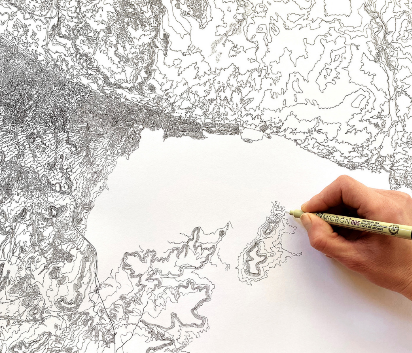Articles/Essays – Volume 55, No. 3
ART NOTE Black Joy
When the Stop Your Silence organization began in the spring of 2020, our goal was to create a safe space where Brigham Young University students of color could share their stories of racist discrimination and hardships and find community, healing, and support. Via Instagram, we rapidly received hundreds of stories and began to expand our content and audience not only to people of color but to white members of the Church. We realized there was a need for antiracist education specifically geared toward Latter-day Saints that showed how our doctrines and beliefs not only encourage but exhort us as disciples of Christ to mourn with those who mourn and take a stand against racial injustice.
I was initially drawn to Mikenzi Jones’s work for how it unapologetically displays femininity. Through vibrant yet soft shades, organic line work, and a vast range of skin tones and body compositions, Jones’s artwork reflects the stunning essence of womanhood and all its diversity. Positive, euphoric, non-sexualized artwork for women can be difficult to find. But Jones is able to capture the beauty of women and the wondrous work that can be accomplished when they come together across racial, cultural, and national divides.
A common struggle Latter-day Saints of color have expressed to us at Stop Your Silence was a lack of representation. Whether it be in their congregations, in Church leadership, in music or worship styles, these Saints feel disregarded and unheard for a multitude of reasons. However, there was one area in particular regarding representation that came up repeatedly: the overwhelmingly whitewashed depictions of Christ, God, and scriptural figures. The most well-known and highly circulated artistic renderings in the LDS art tradition tend to depict white, hypermasculine men. There was a lack of artwork that featured women from scripture and people of color that didn’t fall into the racist “black-skinned” Lamanite caricature. With this in mind, we made it a priority to only highlight art that depicted people of color. Our page is filled with renderings of Black Heavenly Mothers, Indigenous angels, brown-skinned Christs, and more. It is our belief that our Heavenly Parents blessed the world by creating a beautifully diverse human population, and that every child of God deserves to see themselves represented in the divine. To deny someone that connection with God and to force God to fit solely in the square of whiteness is damaging to all of us. It is paramount to our relationship as human beings to see each other and God fully and honestly, to see clearly the stunning medley of divine creation on this earth.
The cover art for this issue in particular also highlights something that for me, as a Black woman, is often overlooked in art: joy. Oftentimes Black women are shown and described as strong, confident, independent, and persevering. These are all qualities that many Black women exude and epitomize, but what is missing is their inner happiness and joy. Black women are rarely given the space to simply exist and be joyous, to reside in a space that isn’t defined by activism, emotional labor, and work. The Black woman on the cover of this issue effuses a joy and radiance that I hope all Black women, but especially Black Mormon women, can experience as they navigate this world. While they remain confident and strong, I hope they, too, can have joy.
Note: The Dialogue Foundation provides the web format of this article as a courtesy. Please note that there may be unintentional differences from the printed version. For citational and biographical purposes, please use the printed version or the PDFs provided online and on JSTOR.


 Back to full Issue
Back to full Issue

